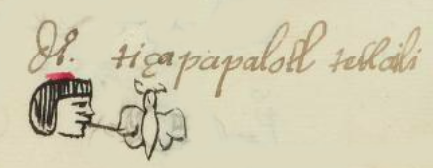Tizapapalotl (MH879v)
This black-line drawing of the simplex glyph for the personal name Tizapapalotl (“Chalk-Colored Butterfly”) is attested here as a man’s name. The glyph shows a frontal or bird’s eye view of a butterfly with its wings spread. It has two antennae that curve inward toward the head.
Stephanie Wood
It is unclear if this butterfly is anything more than one of a certain color, but the butterfly has some relationship to Ecatl (or Ehecatl, the divine force of the wind), as the two names sometimes merge. The butterfly also has a connection to obsidian, given the recurring name Itzpapalotl (the Earth-Mother divine force), and to fire (e.g., Tlepapalotl). Warfare associations include the warrior costume of the butterfly.
Stephanie Wood
dio. tiçapapalotl
Diego Tizapapalotl
Stephanie Wood
1560
Jeff Haskett-Wood
mariposas, insectos, volar, tiza, color blanco, nombres de hombres

tizapapalo(tl), a chalk-colored butterfly, https://nahuatl.wired-humanities.org/content/tizapapalotl
Mariposa Color Tiza
Stephanie Wood
Matrícula de Huexotzinco, folio 879v, World Digital Library, https://www.loc.gov/resource/gdcwdl.wdl_15282/?sp=831&st=image.
This manuscript is hosted by the Library of Congress and the World Digital Library; used here with the Creative Commons, “Attribution-NonCommercial-ShareAlike 3.0 License” (CC-BY-NC-SAq 3.0).







